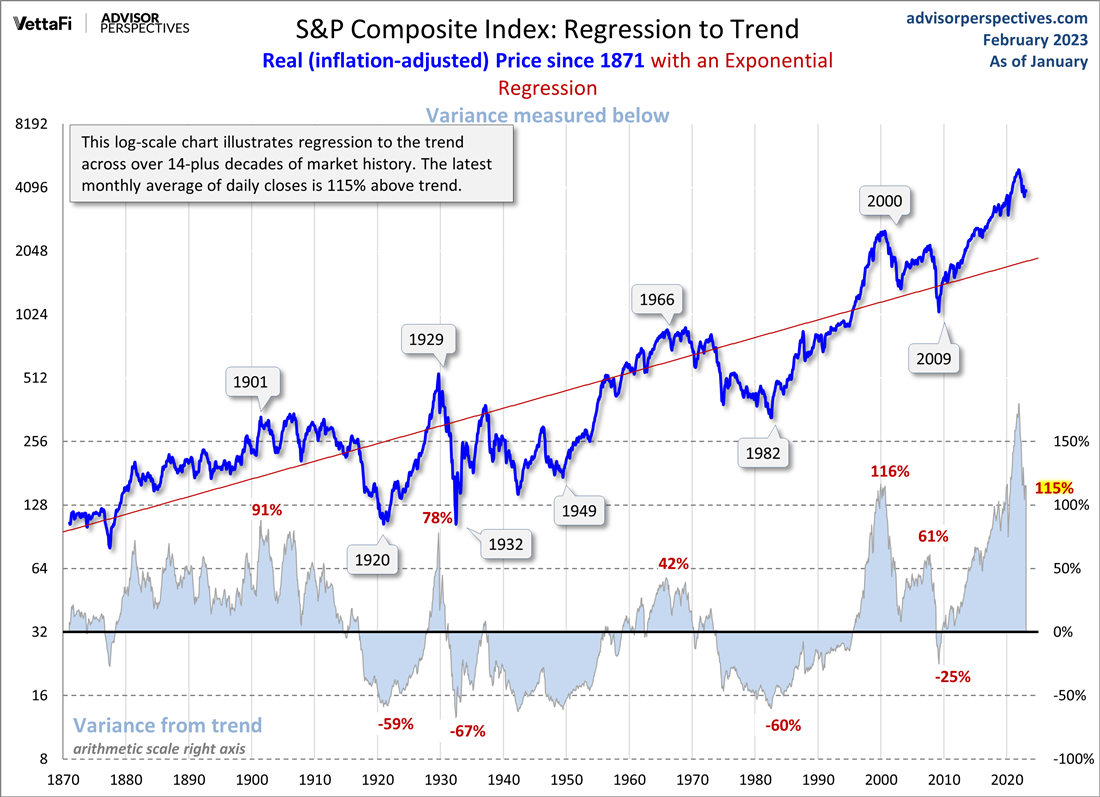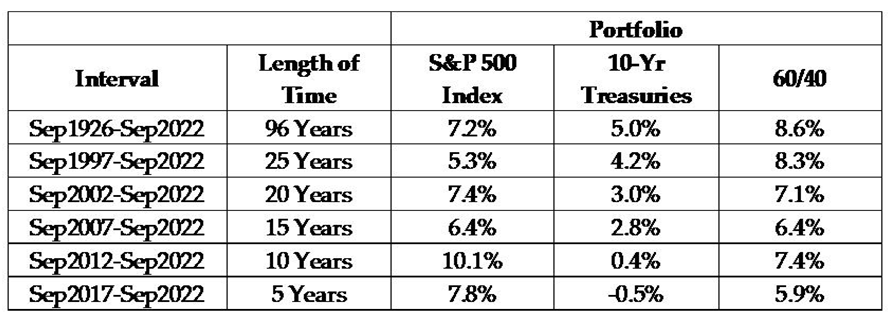The market's weighing machine will be apparent this year as it siphons the rest of the COVID money. Equities remain criminally overvalued, and an overconfident bear market rally looks to be a trap ready to be sprung on wayward investors.
Dividends paid by blue chip dividend kings or aristocrats are likely to yield a degree of safety, despite the expected capital depreciation in the short term.
A few pieces of evidence suggest where we’re heading this year and why a portfolio of mature dividend stocks and diversified investments will survive.
Reverting to the mean
Returns of stocks and S&P 500 follow a normal distribution, with most prices centered around a secular or long-term moving average.
In the graph below, we are around four standard deviations above the line of best fit or regression trend line. With data stretching back to 1870, we have always reverted to and intersected this line sooner or later. Another observation is that even if the slope of the trendline moves with time to catch up to us, we’re presently so far above it that we’d need to price in decades worth of sideways price action for this to be possible.

Earnings of companies in the S&P 500 have also not grown fast enough to support the once-in-a-lifetime COVID rally that was ushered in under extraordinary circumstances and artificially engineered.
The 10-year P/E ratio of the index is 29.1, which is 1.1 standard deviations above the long-term market average of 19.6. Financial ratios are also mean-reverting.
What’s next?
With the thesis in mind that we’ll always come to meet the average sooner or later, now is a good time to discuss how dividends and diversification in instruments other than equities work to boost total returns.
For example, a portfolio comprising 60% stocks and 40% bonds has outperformed the S&P 500 index for the last 96 years, according to Chris Leithner from Livewire. But why is this the case?

The short answer is that a diversified portfolio with 40% bonds incurs short-term losses much less frequently than one with only equities exposure.
Bonds in a portfolio mean it has less potential to move up and down. And downside volatility is extremely undesirable in a portfolio due to how the math of how losses work.
If your portfolio loses 10% of its value, you must yield an 11% gain to break even. But if your portfolio loses 50%, you’ll need to yield a 100% gain to do the same. This process repeats as larger and larger losses require exponential gains to play catch up, which makes volatility destructive for building wealth.
But why dividends?
The more dividends your portfolio earns each year, the less room your portfolio has to make a loss, even if your stocks are down. Since your losses are reduced through the quality income of dividend payments, you have a greater chance of breaking even on bad years to benefit more from compounding returns from good ones.
According to a whitepaper published by Hartford Funds, 84% of the total return of the S&P 500 can be chalked up to dividend payments and investors reinvesting and calculating those dividends to yield compounding returns.
Another insight gleaned from the paper is that dividends alone contributed 40% to the index’s total return since the 1930s. So even when the index recorded large losses during market crashes and recessions, dividends kept investor returns ticking over.
Some practical considerations to take away from this is that a correction in the index is inevitable as prices cannot keep going up forever. The largest bull run for equities in history has ended or paused momentarily, and there’s no guarantee that a similar performance will continue moving forward.
The 60/40 portfolio consisting of stocks and bonds has outperformed historically. If it were not for the bull run that took place for nearly a decade that pushed companies’ valuations completely out of whack, this would also be reflected in more recent periods.
Buying quality dividend stocks such as dividend kings and dividend aristocrats may be desirable, along with diversifying into bonds or other asset types like physical real estate, gold, art, and cryptocurrencies.
Before you make your next trade, you'll want to hear this.
MarketBeat keeps track of Wall Street's top-rated and best performing research analysts and the stocks they recommend to their clients on a daily basis.
Our team has identified the five stocks that top analysts are quietly whispering to their clients to buy now before the broader market catches on... and none of the big name stocks were on the list.
They believe these five stocks are the five best companies for investors to buy now...
See The Five Stocks Here
Looking for the next FAANG stock before everyone has heard about it? Enter your email address to see which stocks MarketBeat analysts think might become the next trillion dollar tech company.
Get This Free Report
Like this article? Share it with a colleague.
Link copied to clipboard.